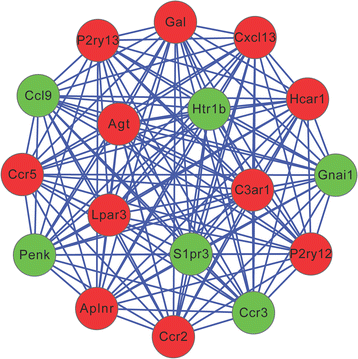Transcriptomic analyses reveal the underlying pro-malignant functions of PTHR1 for osteosarcoma via activation of Wnt and angiogenesis pathways
- PMID: 29121993
- PMCID: PMC5679487
- DOI: 10.1186/s13018-017-0664-2
Transcriptomic analyses reveal the underlying pro-malignant functions of PTHR1 for osteosarcoma via activation of Wnt and angiogenesis pathways
Abstract
Background: Increasing evidence has indicated parathyroid hormone type 1 receptor (PTHR1) plays important roles for the development and progression of osteosarcoma (OS). However, its function mechanisms remain unclear. The goal of this study was to further illuminate the roles of PTHR1 in OS using microarray data.
Methods: Microarray data were available from the Gene Expression Omnibus database under the accession number GSE46861, including six tumors from mice with PTHR1 knockdown (PTHR1.358) and six tumors from mice with control knockdown (Ren.1309). Differentially expressed genes (DEGs) between PTHR1.358 and Ren.1309 were identified using the LIMMA method, and then, protein-protein interaction (PPI) network was constructed using data from STRING database to screen crucial genes associated with PTHR1. KEGG pathway enrichment analysis was performed to investigate the underlying functions of DEGs using DAVID tool.
Results: A total of 1163 genes were identified as DEGs, including 617 downregulated (Lef1, lymphoid enhancer-binding factor 1) and 546 upregulated genes (Dkk1, Dickkopf-related protein 1). KEGG enrichment analysis indicated upregulated DEGs were involved in Renin-angiotensin system (e.g., Agt, angiotensinogen) and Wnt signaling pathway (e.g., Dkk1), while downregulated DEGs participated in Basal cell carcinoma (e.g., Lef1). A PPI network (534 nodes and 2830 edges) was constructed, in which Agt gene was demonstrated to be the hub gene and its interactive genes (e.g., CCR3, CC chemokine receptor 3; and CCL9, chemokine CC chemokine ligand 9) were inflammation related.
Conclusions: Our present study preliminarily reveals the pro-malignant effects of PTHR1 in OS cells may be mediated by activating Wnt, angiogenesis, and inflammation pathways via changing the expressions of the crucial enriched genes (Dkk1, Lef1, Agt-CCR3, and Agt-CCL9).
Keywords: Angiogenesis; Inflammation; Osteosarcoma; PTHR1; Wnt pathway.
Conflict of interest statement
Ethics approval
This article does not contain any studies with human participants or animals performed by any of the authors.
As the data used in this study was downloaded from GEO database and no human experiment was involved in this study, there was no informed consent.
Consent for publication
Not applicable.
Competing interests
The authors declare that they have no competing interest.
Publisher’s Note
Springer Nature remains neutral with regard to jurisdictional claims in published maps and institutional affiliations.
Figures



Similar articles
-
Parathyroid hormone type 1 receptor regulates osteosarcoma K7M2 Cell growth by interacting with angiotensinogen.J Cell Mol Med. 2021 Mar;25(6):2841-2850. doi: 10.1111/jcmm.16314. Epub 2021 Jan 28. J Cell Mol Med. 2021. PMID: 33511766 Free PMC article.
-
PTHR1 in osteosarcoma: Specific molecular mechanisms and comprehensive functional perspective.J Cell Mol Med. 2021 Apr;25(7):3175-3181. doi: 10.1111/jcmm.16420. Epub 2021 Mar 6. J Cell Mol Med. 2021. PMID: 33675132 Free PMC article. Review.
-
PTHR1 May Be Involved in Progression of Osteosarcoma by Regulating miR-124-3p-AR-Tgfb1i1, miR-27a-3p-PPARG-Abca1, and miR-103/590-3p-AXIN2 Axes.DNA Cell Biol. 2019 Nov;38(11):1323-1337. doi: 10.1089/dna.2019.4880. Epub 2019 Sep 19. DNA Cell Biol. 2019. PMID: 31536386
-
Integrated network analysis to explore the key genes regulated by parathyroid hormone receptor 1 in osteosarcoma.World J Surg Oncol. 2017 Sep 21;15(1):177. doi: 10.1186/s12957-017-1242-0. World J Surg Oncol. 2017. PMID: 28934958 Free PMC article.
-
Identification of key genes in osteosarcoma by meta‑analysis of gene expression microarray.Mol Med Rep. 2019 Oct;20(4):3075-3084. doi: 10.3892/mmr.2019.10543. Epub 2019 Jul 31. Mol Med Rep. 2019. PMID: 31432118 Free PMC article.
Cited by
-
Convallatoxin suppresses osteosarcoma cell proliferation, migration, invasion, and enhances osteogenic differentiation by downregulating parathyroid hormone receptor 1 (PTHR1) expression and inactivating Wnt/β-catenin pathway.Bioengineered. 2022 May;13(5):13280-13292. doi: 10.1080/21655979.2022.2080363. Bioengineered. 2022. PMID: 35635031 Free PMC article.
-
Parathyroid hormone type 1 receptor regulates osteosarcoma K7M2 Cell growth by interacting with angiotensinogen.J Cell Mol Med. 2021 Mar;25(6):2841-2850. doi: 10.1111/jcmm.16314. Epub 2021 Jan 28. J Cell Mol Med. 2021. PMID: 33511766 Free PMC article.
-
Roles of Parathyroid Hormone-Related Protein (PTHrP) and Its Receptor (PTHR1) in Normal and Tumor Tissues: Focus on Their Roles in Osteosarcoma.Front Vet Sci. 2021 Mar 16;8:637614. doi: 10.3389/fvets.2021.637614. eCollection 2021. Front Vet Sci. 2021. PMID: 33796580 Free PMC article. Review.
-
Exploring the key genes and pathways of side population cells in human osteosarcoma using gene expression array analysis.J Orthop Surg Res. 2018 Jun 19;13(1):153. doi: 10.1186/s13018-018-0860-8. J Orthop Surg Res. 2018. PMID: 29921292 Free PMC article.
-
PTHR1 in osteosarcoma: Specific molecular mechanisms and comprehensive functional perspective.J Cell Mol Med. 2021 Apr;25(7):3175-3181. doi: 10.1111/jcmm.16420. Epub 2021 Mar 6. J Cell Mol Med. 2021. PMID: 33675132 Free PMC article. Review.
References
-
- Avnet S, Longhi A, Salerno M, Halleen JM, Perut F, Granchi D, et al. Increased osteoclast activity is associated with aggressiveness of osteosarcoma. Int J Oncol. 2008;33:1231–1238. - PubMed
MeSH terms
Substances
LinkOut - more resources
Full Text Sources
Other Literature Sources
Medical
Research Materials
Miscellaneous

